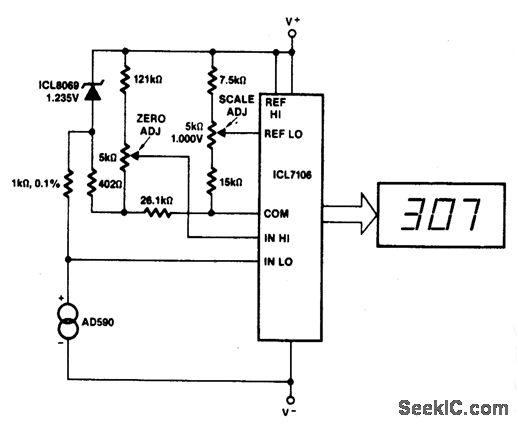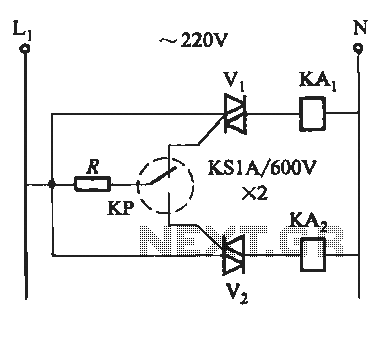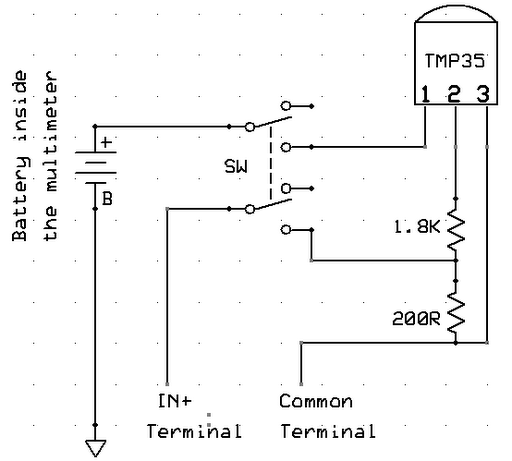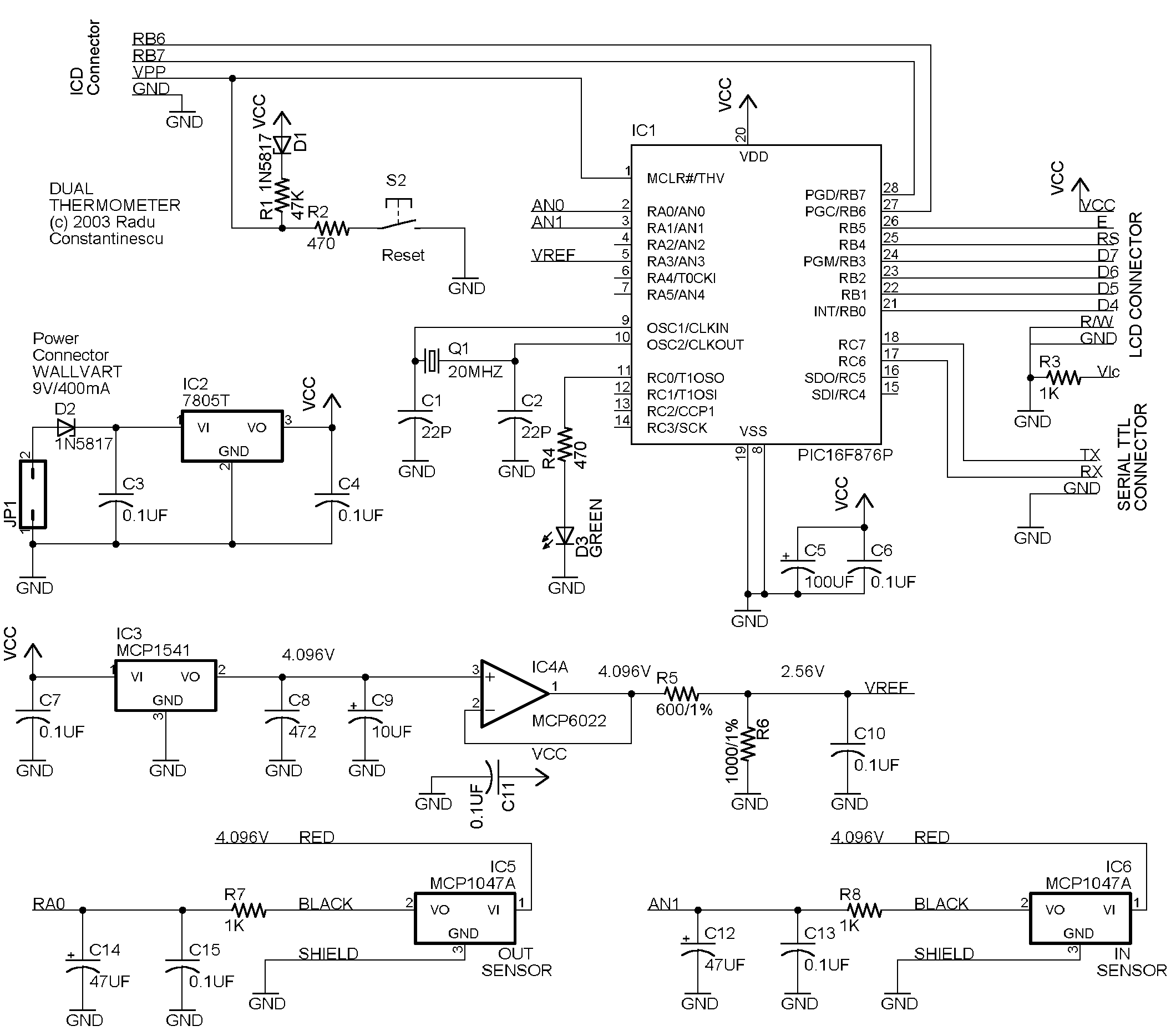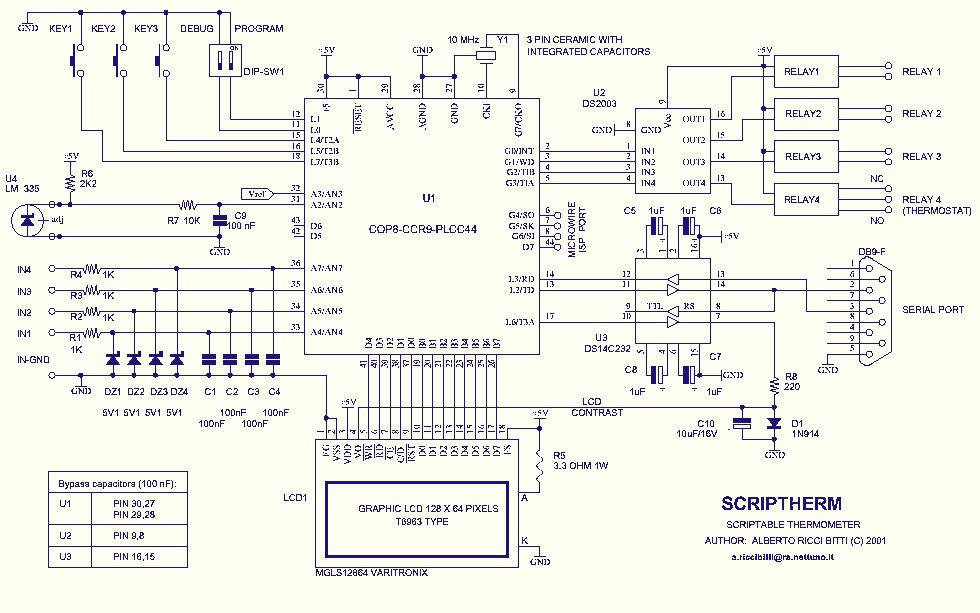
THERMOMETER ADAPTER
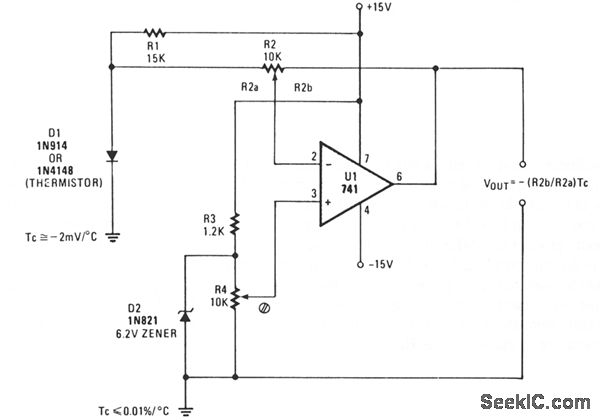
A simple operational amplifier and silicon diode form the core of a temperature-to-voltage converter, allowing the use of a standard voltmeter—either analog or digital—to measure temperature. User adjustments enable readings of either 10 mV or 100 mV to correspond to 1 °F or °C. The temperature sensor D1 is a 1N4148 silicon diode, which has a temperature coefficient of -2 mV/°C. U1 is a 741 operational amplifier configured as a differential amplifier. A voltage divider composed of R3 and Zener diode D2 supplies a 6.2 V reference voltage. D2 is parallel to potentiometer R4, enabling offset adjustments to align the output voltage with either the Celsius or Fahrenheit scale, as preferred. Gain control R2 is set to ensure the op amp's output matches the scale or voltage range of the meter in use. Subsequently, R4, the offset adjustment control, is calibrated so the output voltage reflects either degrees Fahrenheit or Celsius. The thermometer adapter can be fine-tuned by adjusting R4 while the probe sensor is exposed to a known temperature.
The temperature-to-voltage converter circuit utilizes a 741 operational amplifier (U1) configured in a differential amplifier setup. The 1N4148 silicon diode (D1) serves as the temperature sensor, exhibiting a temperature coefficient of -2 mV/°C, which means for every degree Celsius increase in temperature, the voltage output decreases by 2 mV. This characteristic is crucial for converting temperature readings into corresponding voltage levels.
The reference voltage for the operational amplifier is established via a voltage divider network comprising resistor R3 and Zener diode D2, which provides a stable 6.2 V. The Zener diode contributes to maintaining a consistent voltage level, essential for accurate temperature measurements. Potentiometer R4 is connected in parallel with D2, allowing for fine-tuning of the offset voltage. This adjustment is vital for calibrating the output voltage to align with either the Celsius or Fahrenheit scale, depending on user preference.
Gain control is achieved through resistor R2, which adjusts the amplification factor of the op amp output. This ensures that the output voltage is appropriately scaled to match the input range of the measuring device, whether it is analog or digital. After setting the gain, the user can adjust R4 to calibrate the output voltage to represent either degrees Fahrenheit or Celsius accurately.
To ensure precise measurements, the thermometer adapter can be calibrated by adjusting R4 while the diode sensor is placed in an environment with a known temperature. This calibration process guarantees that the converter provides accurate voltage readings corresponding to specific temperature values, facilitating reliable temperature monitoring and measurement applications.A simple op amp and silicon diode are the heart of the temperature-to-voltage converter that will permit you to use an ordinary voltmeter-either analog or digital-to measure temperature. User adjustments make it possible for a reading of either 10 mV or 100 mV to represent 1 °F or C. Temperature sensor D1 is a 1N4148 silicon diode. It has a temper ature coefficient of -2 mV/ °C. U1, a 741 op amp, is connected as a differential amplifier. A voltage divider consisting of R3 and Zener diode D2 provides a 6. 2 V reference voltage. D2 is shunted by potentiometer R4, so that the offset can be adjusted to align the output voltage with either the Celsius or Fahrenheit scale, as desired. Gain control R2 is adjusted so the output of the op amp is in the scale or voltage range of the meter being used.
R4, the offset adjust control, is then adjusted so the output voltage represents either degrees F or C. The thermometer adapter can be calibrated by adjusting R4 while the probe sensor is at a known temperature.
🔗 External reference
The temperature-to-voltage converter circuit utilizes a 741 operational amplifier (U1) configured in a differential amplifier setup. The 1N4148 silicon diode (D1) serves as the temperature sensor, exhibiting a temperature coefficient of -2 mV/°C, which means for every degree Celsius increase in temperature, the voltage output decreases by 2 mV. This characteristic is crucial for converting temperature readings into corresponding voltage levels.
The reference voltage for the operational amplifier is established via a voltage divider network comprising resistor R3 and Zener diode D2, which provides a stable 6.2 V. The Zener diode contributes to maintaining a consistent voltage level, essential for accurate temperature measurements. Potentiometer R4 is connected in parallel with D2, allowing for fine-tuning of the offset voltage. This adjustment is vital for calibrating the output voltage to align with either the Celsius or Fahrenheit scale, depending on user preference.
Gain control is achieved through resistor R2, which adjusts the amplification factor of the op amp output. This ensures that the output voltage is appropriately scaled to match the input range of the measuring device, whether it is analog or digital. After setting the gain, the user can adjust R4 to calibrate the output voltage to represent either degrees Fahrenheit or Celsius accurately.
To ensure precise measurements, the thermometer adapter can be calibrated by adjusting R4 while the diode sensor is placed in an environment with a known temperature. This calibration process guarantees that the converter provides accurate voltage readings corresponding to specific temperature values, facilitating reliable temperature monitoring and measurement applications.A simple op amp and silicon diode are the heart of the temperature-to-voltage converter that will permit you to use an ordinary voltmeter-either analog or digital-to measure temperature. User adjustments make it possible for a reading of either 10 mV or 100 mV to represent 1 °F or C. Temperature sensor D1 is a 1N4148 silicon diode. It has a temper ature coefficient of -2 mV/ °C. U1, a 741 op amp, is connected as a differential amplifier. A voltage divider consisting of R3 and Zener diode D2 provides a 6. 2 V reference voltage. D2 is shunted by potentiometer R4, so that the offset can be adjusted to align the output voltage with either the Celsius or Fahrenheit scale, as desired. Gain control R2 is adjusted so the output of the op amp is in the scale or voltage range of the meter being used.
R4, the offset adjust control, is then adjusted so the output voltage represents either degrees F or C. The thermometer adapter can be calibrated by adjusting R4 while the probe sensor is at a known temperature.
🔗 External reference
Warning: include(partials/cookie-banner.php): Failed to open stream: Permission denied in /var/www/html/nextgr/view-circuit.php on line 713
Warning: include(): Failed opening 'partials/cookie-banner.php' for inclusion (include_path='.:/usr/share/php') in /var/www/html/nextgr/view-circuit.php on line 713

